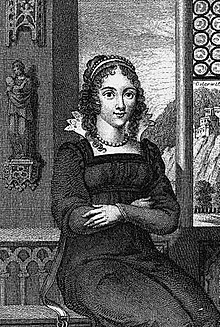Veronika of Desenice
Veronika of Desenice | |
|---|---|
| Countess of Celje Princess of the Holy Roman Empire | |
 Veronika of Desinić (1817) | |
| Died | 17 October 1425 Ojstrica Castle, Loke, Duchy of Styria |
| Spouse(s) | Frederick II, Count of Celje |
Veronika of Desenice (Slovene: Veronika Deseniška or Veronika z Desenic; died 17 October 1425)[1] was the second wife of Frederick II, Count of Celje. She is known for having been subjected to a witch trial by her father-in-law, who objected to her marriage to his son, but failed to have her condemned and instead had her imprisoned and murdered.
Early life[edit]
Little is known of her early life. It is believed the name Deseniška derives from the village of Desinić in Croatia, where Frederick also had extensive estates, and it appears in the forms Dessnitz, Dessenitz, Desnicze, Teschnitz, Teschenitz, and Dessewitz in various historical sources. The toponym Desenice is a back-formation from the adjective Deseniška.
She was possibly employed as a maid to Elizabeth of Frankopan, the first wife of Frederick II, Count of Celje.[2]
Marriage and persecution[edit]
When Elizabeth of Frankopan suddenly died in 1422, Frederick was accused of having murdered her to be able to marry his mistress Veronika[3], and Frederick's father Hermann II, Count of Celje accused his son of having comitted adultary with Veronika.[4]
Fredrick negotiated with the Republic of Venice to assure protection for him and Veronika; his negotiations proved successful in 1425, and the same year, he married Veronika against the will of his father was well as the Emperor Sigismund.[5] Veronika was of lesser status,[1] and Frederick's father Hermann II was greatly opposed to the marriage.
Emperor Sigismund called upon Fredrick, and on his arrival had him captured and returned to his father. The chronicles of the Counts of Celje suggest he had his son arrested and, while holding him prisoner, initiated a witch trial against Veronika, accusing her of having enchanted Frederick and attempted to murder Hermann II by posion.[6] The witch trial failed; provided with good defense, she was acquitted by the court on lack of evidence.[7]
Murder[edit]
Despite the court's ruling, her father-in-law had her incarcerated in Ojstrica Castle near Tabor and murdered, supposedly on the orders of Hermann II, who reportedly ordered his knight Jobst von Helfenberg do drown her in her bath 17 October 1425.[8]
She was buried in Braslovče and a few years later Frederick arranged for her remains to be reburied at the Carthusian monastery at Jurklošter and in her memory also made an endowment to the monastery at Bistra.[1]
In culture[edit]
Veronika and Frederick's tragic love story, which also marked the beginning of the end of the House of Cilli, has been an inspiration for numerous literary creations.
Among others, she was the protagonist of Josipina Turnograjska's 1851 story Nedolžnost in sila (Innocence and Force; named Veronika Desinska),[9] Josip Jurčič's 1880 play Veronika Deseniška, Oton Župančič's 1924 play Veronika Deseniška, Bratko Kreft's 1932 play Celjski Grofje (The Counts of Celje), Danilo Švara's 1946 opera Veronika Deseniška, Franček Rudolf's 1968 play Celjski grof na žrebcu (The Count of Celje on a Stallion) and 1974 play Veronika, and Dušan Čater's 1996 children's novel Veronika Deseniška. She has also inspired works in Croatian, German, Czech, and Italian.
The Veronika Poetry Award and the Veronika Festival are named after Veronika of Desenice.[10][11]
The Slovene entry for the Eurovision Song Contest 2024, performed by Raiven, is titled after Veronika.[12]
See also[edit]
References[edit]
- ^ a b c Grafenauer, Bogo (2009). "Veronika Deseniška" [Veronika of Desenice]. In Vide Ogrin, Petra (ed.). Slovenski biografski leksikon (in Slovenian). ISBN 978-961-268-001-5.
- ^ Franz Otto Roth: Die „Hexe“ Veronika. Liebeszauber, Adelspolitik und „Renaissance“-Menschen im steirischen frühen 15. Jahrhundert. In: Mitteilungen des steiermärkischen Landesarchivs. Band 37, Graz 1987, ZDB-ID 510427-0. p. 58-62
- ^ Franz Otto Roth: Die „Hexe“ Veronika. Liebeszauber, Adelspolitik und „Renaissance“-Menschen im steirischen frühen 15. Jahrhundert. In: Mitteilungen des steiermärkischen Landesarchivs. Band 37, Graz 1987, ZDB-ID 510427-0. p. 58-62
- ^ Franz Otto Roth: Die „Hexe“ Veronika. Liebeszauber, Adelspolitik und „Renaissance“-Menschen im steirischen frühen 15. Jahrhundert. In: Mitteilungen des steiermärkischen Landesarchivs. Band 37, Graz 1987, ZDB-ID 510427-0. p. 58-62
- ^ Ingrid Roitner: Desinić (Desenik, Deschenitz, Teschnitz) Veronika von: Geliebte und zweite Frau Graf Friedrichs II. von Cilli († 1454). In: Ilse Korotin (Hrsg.): biografıA. Lexikon österreichischer Frauen. Band 1: A–H. Böhlau, Wien/Köln/Weimar 2016, ISBN 978-3-205-79590-2, S. 879.
- ^ Franz Otto Roth: Die „Hexe“ Veronika. Liebeszauber, Adelspolitik und „Renaissance“-Menschen im steirischen frühen 15. Jahrhundert. In: Mitteilungen des steiermärkischen Landesarchivs. Band 37, Graz 1987, ZDB-ID 510427-0. p. 58-61
- ^ Franz Otto Roth: Die „Hexe“ Veronika. Liebeszauber, Adelspolitik und „Renaissance“-Menschen im steirischen frühen 15. Jahrhundert. In: Mitteilungen des steiermärkischen Landesarchivs. Band 37, Graz 1987, ZDB-ID 510427-0. p. 58-61
- ^ Franz Otto Roth: Die „Hexe“ Veronika. Liebeszauber, Adelspolitik und „Renaissance“-Menschen im steirischen frühen 15. Jahrhundert. In: Mitteilungen des steiermärkischen Landesarchivs. Band 37, Graz 1987, ZDB-ID 510427-0. p. 61-62
- ^ Josipina Turnograjska (1921). "Nedolžnost in sila". In Lah, Ivan (ed.). Josipina Turnograjska: Njeno življenje in delo. Maribor: Tisk Mariborske tiskarne. p. 64. Retrieved January 21, 2024.
- ^ Veronika Award site
- ^ Veronika Award on Culture.si Ministry of Culture of the Republic of Slovenia site
- ^ "Raiven brings her ethereal symphony from Slovenia". Eurovision.tv. EBU. 2023-12-12. Retrieved 2023-12-12.
